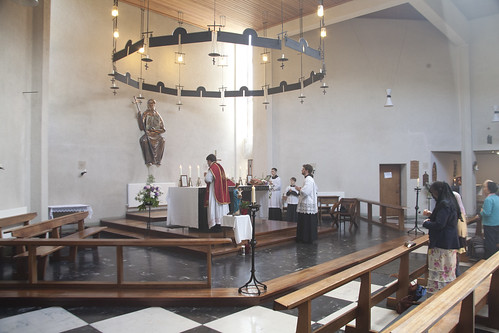
The southern part of Oxford is part of Portsmouth Diocese, since the Thames is the diocesan boundary: as it was in the Middle Ages. So just outside Birmingham Archdiocese, at the modern church of Holy Rood in the Abingdon Road, Fr Daniel Lloyd, Parish Priest and member of the Ordinariate of Our Lady of Walsingham, celebrated the Ember Saturday of Lent. This Mass was sponsored by the Latin Mass Society and accompanied by the Schola Abelis, Oxford's dedicated Chant schola (the Oxford Gregorian Chant Society).

I'm not going to claim that this is the style of church I would choose above all others if I was allowed to choose... no one would believe me anyway. But as a matter of fact this church was built for the Traditional Mass, and the first Masses here were celebrated facing East, as it was last Saturday. Today the EF is celebrated every Friday at 12:30pm, and it is also the place in Oxford to find the Ordinariate Use.

We had the full set of readings for the Ember Saturday, giving us a wonderful collection of texts - Scripture, collects, and chants - to deepen our appreciation of Pentecost.
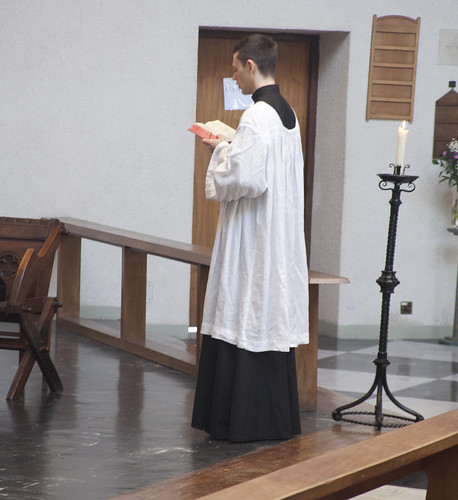
It is correct to say that great church architecture is appropriate for the Mass, and helps to lift the heart and mind to God: as does great liturgical music, and also smaller things like vestments and church plate. But I rather resist the idea that some styles of architecture render a church 'unsuitable' for the Extraordinary Form. If there is room to genuflect in front of the altar, and space for the ceremonies, then it is possible to celebrate the EF, and it is always good to celebrate the EF.

Modern churches tend to have plenty of space: the problem with space comes from churches where the altar has been moved towards the nave from a historic position against the end wall. Modern churches also tend to have good acoustics: the problem for acoustics tends to come from excessive carpeting, blessedly absent from Holy Rood.

At any rate, I'd rather attend Mass in a modernist car park, which has been dedicated to Catholic worship, than in a Gothic masterpiece which has been secularised. And Holy Rood is not as bad as that by a long chalk - for the real modernist car park experience you have to go to the 'underground basilica' in Lourdes where the SSPX has celebrated Mass for pilgrims.
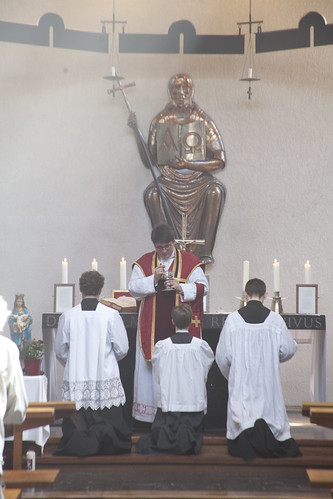
If the architects of that monstrosity and, perhaps, the forward-looking builders of Holy Rood, are turning in their graves at these developments, that's fine by me.
And thus the whirligig of time brings in his revenges.
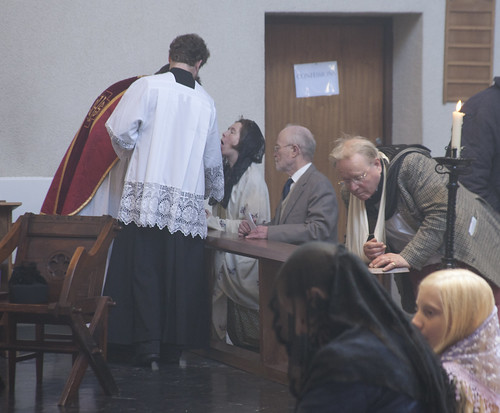
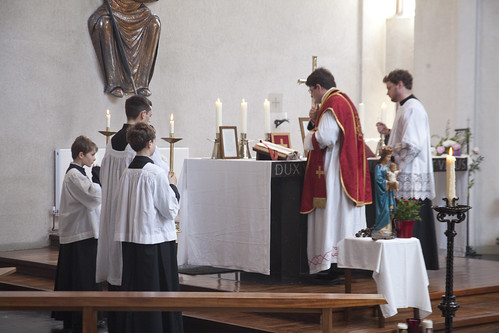
Support the work of the LMS by becoming an 'Anniversary Supporter'.
Though of course I understand your remark and its spirit, one has to be wary of assuming the architects of the Lourdes car park or Holy Cross are indeed turning in their graves at such moments: it is clear that this sort of dreadful architecture was part of a widespread aesthetic fashion in the church, and not one followed solely by the most ardent progressives. A case in point is the benedictine abbey of Randol in the Auvergne, first daughter house of Fontgombault, which has more in common with the set of Thunderbirds than Christian tradition. Though the abbey is unquestionably a product of its times, the monks who built it and founded it were never exactly at the vanguard of liturgical modernism, following their mother house in hte return to the traditional office and Mass as soon as it was possible.
ReplyDeleteAll that to say that, bizarre though it may seem, those that built these modernist carbuncles might in fact be more shocked at the Novus Ordo than one might otherwise assume. Though many went along with aesthetic fashion at the time, at least some applied the handbrake when they believed things went too far.
That's an interesting point.
DeleteOn the other hand the trend througout the 20th century towards shortening and widening churches, which finds it apotheosis in circular churches like Holy Rood, reflects a very different attitude towards liturgical participation than that reflected by Puginesque churches with Rood Screens. And that the former is closer to the attitude of the liturgical reformers.
I think a lot of the people who paved the way for the liturgical revolution would have been horrified by what happened in the end: and indeed, some lived long enough to express their horror. It's still true that they paved the way for it, conceptually and in other ways.